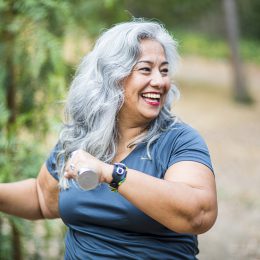6 Age-Related Vision Problems and What to Do About Them
When it comes to preserving your sight, you have more power than meets the eye.

Some things, like your priorities and sense of self, become clearer with age. Your eyesight is not usually one of them.
Even if you’ve enjoyed 20/20 vision your whole life, you may suddenly find yourself struggling. The good news: If you educate yourself, control some risk factors, and quickly get help for any problems that arise, you’ll have a much better shot of preserving your eyesight for the years to come.
Here are six common vision problems that affect older adults—and what you can do about each.
Get and stay fit with SilverSneakers! Classes and events are happening right now at participating gyms, online through SilverSneakers LIVE, and at community centers near you. Activate your free online account to get started.
Problem #1: Dry Eye
What it is: As you get older, the quality and quantity of tear production decreases. This makes it more difficult to keep your eyes moist and comfortable.
“Dry eyes become much more common after age 40, with a markedly increased prevalence in seniors,” says Alan D. Mendelsohn, M.D., an ophthalmologist in Miami.
While dry eye is fair game for anyone, it is more likely to affect the following:
- Individuals age 50 and up
- Women
- Anyone with an autoimmune condition like lupus or Sjögren syndrome
- Individuals who don’t get enough Vitamin A or omega-3 fatty acids
The result: Your eyes feel scratchy, as if something is stuck in them. You might also have redness, stinging, or burning.
What you can do: Talk to your doctor about the best solution for you. Over-the-counter treatments like artificial tears and ointments may help. But prescription medication and procedures like punctal plugs sometimes work better.
Punctal plugs are sometimes called punctum plugs, lacrimal plugs, or occluders. They are very small devices that are placed into your tear ducts. They prevent fluid from draining from the eye. The result is that the eye stays moist.
Helpful hints: A few lifestyle changes can go a long way toward improving dry eye symptoms. Try the following:
- Drink plenty of water throughout the day
- Sleep seven to eight hours per night
- Use a humidifier
- Take several screen breaks throughout the day
Problem #2: Cataracts
What it is: Cataracts happen when protein that’s naturally found in the eye starts to clump together, making the lens cloudy and obscuring vision.
The older you are, the higher your risk: By age 80, more than half of Americans have had at least one cataract, according to the National Eye Institute (NEI).
You might first notice that you’re having more trouble driving at night, says Dr. Mendelsohn. “Oncoming headlights begin to become bothersome,” he says.
What you can do: In the early stages, a new pair of glasses may be all that’s needed. You can also make some simple lifestyle adjustments, like adding brighter lights at home, or using a magnifier.
If you get to the point where cataracts are interfering with your ability to do everyday tasks, it may be time for surgery.
Helpful hint: The word “surgery” may have gotten your attention, but these days many patients simply need a short outpatient procedure.
Problem #3: Night blindness
What it is: Night blindness is also called nyctalopia. It makes it difficult for people to see in dim or darker-than-usual places. If you have trouble with the transition from brighter places to less well-lit places, it could be affecting you.
Possible causes include cataracts, myopia (nearsightedness), retinitis pigmentosa, a Vitamin A deficiency, and diabetes. It can also be caused by medications for glaucoma that constrict the pupil.
What you can do: If you are experiencing night blindness, talk to your eye doctor. Your treatment will depend on the cause of the problem.
In some instances, new glasses may be all the fix that’s needed. If a particular medication is found to be the culprit, a new medication may help. And if cataracts are causing night blindness, you may be a good candidate for cataract surgery.
Helpful hint: Night blindness is sometimes caused by a Vitamin A deficiency. Eating foods packed with Vitamin A may make a difference. A few examples include butternut squash, spinach, carrots, cantaloupes, and milk.
Problem #4: Age-Related Macular Degeneration
What it is: The macula is the part of your eye allows you to see clearly what’s right in front of you. It’s with the macula’s help that we can recognize people and other fine details.
Age-related macular degeneration (AMD) happens when the macula is damaged. Once that happens, you cannot see fine detail.
There are two types of AMD:
- Dry AMD: About 80 percent of AMD cases are dry AMD. With this condition, parts of the macula thin with age. In cases of dry AMD, yellow deposits under the retina grow. These are called drusen. Then this happens, you lose your central vision.
- Wet AMD: In cases of wet AMD, abnormal blood vessels grow under the retina. They can leak fluids including blood. This scars the macula and contributes to vision loss fairly quickly.
Macular degeneration is a leading cause of blindness in the United States for people 60 years of age and older, says Dr. Mendelsohn, “and the incidence is rising.”
What you can do: You can reduce your risk in a number of ways. For starters, stay physically active and eat well-balanced meals, reports the NEI.
Research also shows that maintaining healthy blood pressure and cholesterol levels can also help lower your AMD risk.
Another good habit? Wear your sunglasses. The cumulative effect of the sun’s harmful rays can damage the delicate structures of your eye and put you at risk for AMD and other eye problems.
Dr. Mendelsohn encourages patients to wear polarized sunglasses with UV 400 protection when outdoors— even on cloudy days — to cut down glare. That number means they block both UVA and UVB rays.
Also, if you smoke or use tobacco, take steps to quit. Smoking and tobacco damages your eyes (along with many other body parts). You can find free resources to help you quit at Smokefree.gov.
If you have been diagnosed with AMD, an Amsler grid is a helpful tool in learning about whether it is getting worse. This daily DIY self-check involves looking at a square grid with a dot in the middle.
Here’s what you do:
- Look at the grid from about a foot to 15 inches away, in good light. (If you wear glasses to read, wear them for this test.)
- Cover one eye.
- With your uncovered eye, look at the dot. Stay focused on the dot.
- Pay attention to your side vision. Do the grid lines look straight? Do they look wavy, or blurry? Do they look blank?
- Repeat steps 1-4 with your other eye.
If you answered yes about the lines looking wavy, blurry, or blank, set up an appointment with your ophthamologist.
Helpful hints: Eat plenty of fatty fish like wild salmon, since they’re rich in omega-3s that may help keep your eyes healthy. Taking AREDS or AREDS2 supplements—which contain high levels of zinc and antioxidants—may also be worthwhile. But check with your doctor before trying them to avoid any possible interactions with meds you’re already taking.
Problem #5: Glaucoma
What it is: “Glaucoma is called the ‘sneak thief’ in that vision is gradually lost, permanently, and the patient typically has no symptoms nor any idea that damage is occurring,” Dr. Mendelsohn says.
Subscribe to our newsletter
It's quick and easy. You could be one of the 13 million people who are eligible.
Already a member? Click to discover our 15,000+ participating locations.
Follow Us
This condition is caused by increased pressure within the eyeball. It isn’t preventable, but loss of vision from it is. That’s why it’s so important to have an eye doctor treat it promptly, once you are diagnosed.
Glaucoma is the second-leading cause of blindness in the world. About 3 million Americans have this condition.
What you can do: Be sure to keep up with your eye care. If you’re not getting regular eye exams, you might not catch this problem until it’s too late.
Helpful hint: While glaucoma can have many different causes, it can be hereditary. Talk to family members. It could be very helpful to know if someone in your family has been diagnosed.
Problem #6: Diabetic Eye Disease
What it is: More than 25 percent of Americans ages 65 and up have diabetes, and the condition can take quite a toll on your body, including your eyes.
As you get older, your risk of diabetic retinopathy (damaged blood vessels in the retina caused by high blood sugar) and maculopathy (swelling in the area that controls your central vision) increases substantially.
Symptoms can be hard to spot at first. But over time, your blood sugar level can damage your retina.
What you can do: If you have diabetes, work with your doctor to control blood sugar with quarterly A1C tests and at-home testing, if recommended, Dr. Mendelsohn says. Plus, see your eye doctor at least once a year.
Helpful hint: If you are at risk for diabetic eye disease, keep tabs on your blood pressure and cholesterol levels too. As these values go up, so does your risk for developing diabetic retinopathy. Talk to your doctor for suggestions on how to keep your blood pressure and cholesterol levels as low as possible.
Spot Problems Before They Start
No noticeable vision problems? That’s great news—you have the opportunity to be proactive.
If you don’t have diabetes or any known optical disorder, see your eye doctor annually, Dr. Mendelsohn says. If you have high blood pressure or diabetes, ask your doctor how often you should get your eyes checked.
A comprehensive eye exam should include dilation and an evaluation of the optic nerve, macula, and retina using optical coherence tomography (OCT).
“The OCT will detect problems at their inception, and almost always before you develop symptoms,” Dr. Mendelsohn says. If your eye doctor suspects that you have glaucoma, you might also need a visual field test to check your peripheral vision.
See our sources:
Dry Eye: National Eye Institute
Punctual plugs: American Academy of Opthamology
Night blindness: Cleveland Clinic
Age-Related Macular Degeneration: American Academy of Ophthalmology
Amsler Grid: American Academy of Ophthalmology
Glaucoma: American Academy of Ophthalmology
Glaucoma Awareness: Centers for Disease Control and Prevention
Diabetic eye disease: National Eye Institute
Optical coherence tomography: American Academy of Ophthalmology
Comprehensive eye exam or dilated eye exam: National Eye Institute
Check Your SilverSneakers Eligibility Instantly
SilverSneakers members can go to thousands of gyms and fitness locations across the nation, plus take SilverSneakers LIVE online classes that are designed for seniors of all levels. If you have a Medicare plan, it may include SilverSneakers—at no additional cost. Check your eligibility instantly here.
Already a member? Get your SilverSneakers member ID and exclusive fitness content by activating your online account here.
Not eligible for SilverSneakers? You can still get 200+ free SilverSneakers On-Demand videos and stay in touch with us by creating your online account.





